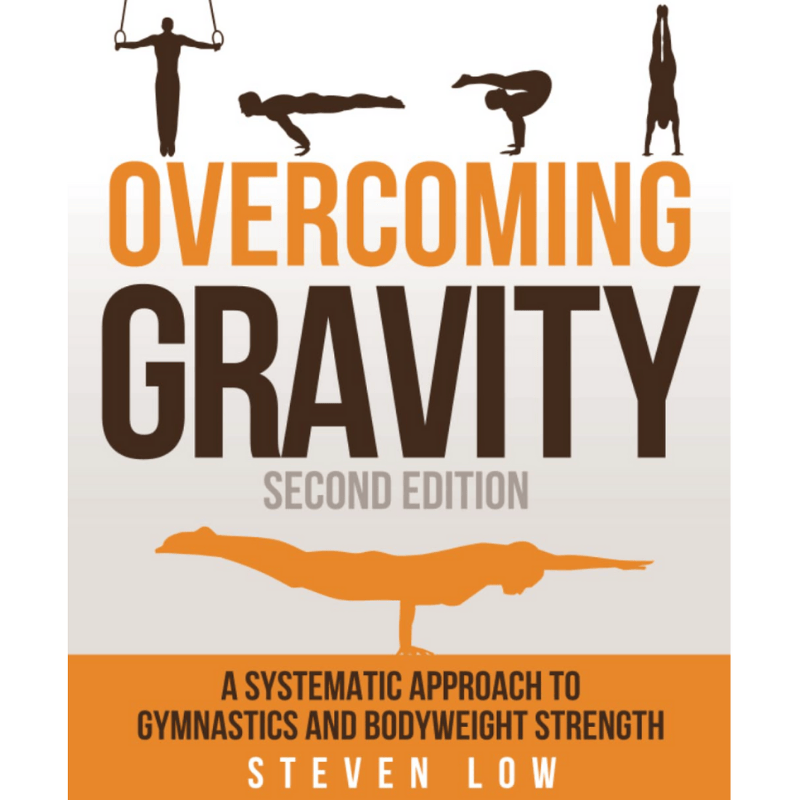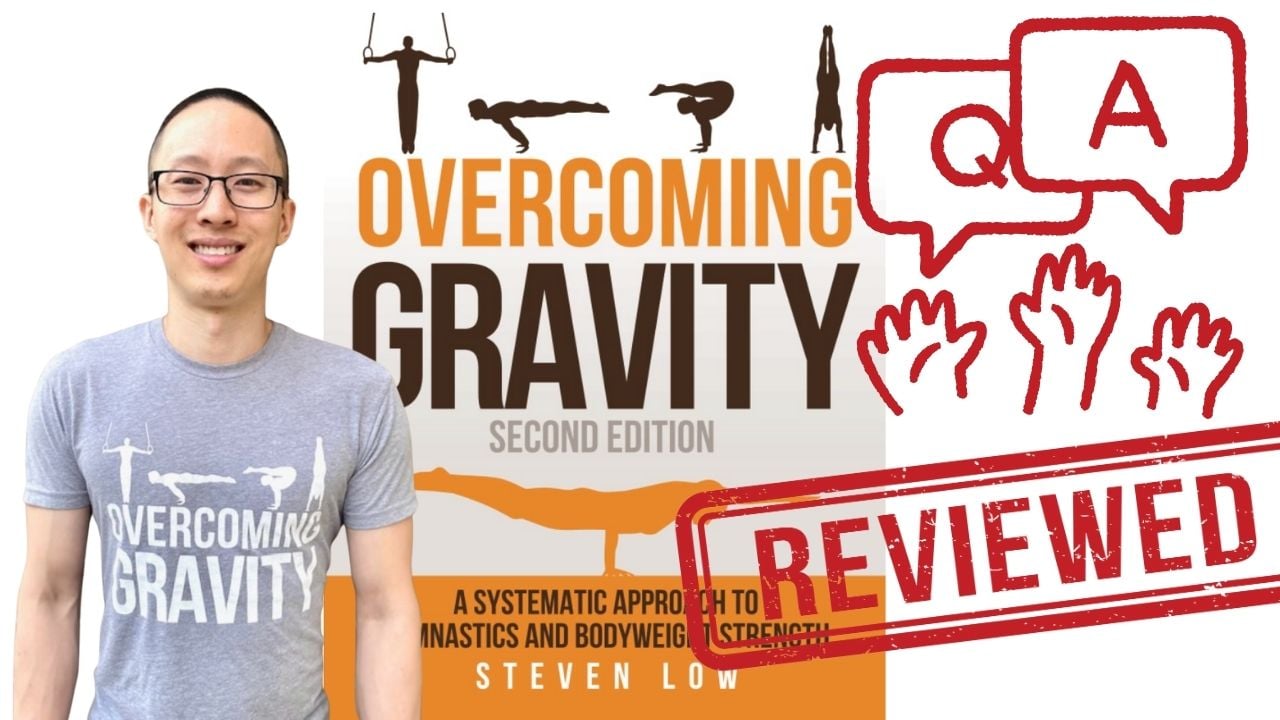As a calisthenics coach, I've always been on the lookout for resources that not only deepen my understanding of bodyweight training but also serve as a guide for athletes at all levels.
Today, I want to introduce you to a cornerstone in the world of calisthenics literature: "Overcoming Gravity" by Steven Low. This book isn't just another training manual; it's a comprehensive exploration of gymnastics and bodyweight strength that has greatly influenced the way we approach our training.

Average Rating: 4.7
- High quality writing and structure
- Thorough and thoughtful
- Customizable programs
- Solid progressions system
- Not ideal for beginners
Pros & Cons
Pros
- This book is highly detailed, covering everything needed for bodyweight and gymnastics-based strength training, including program construction, movement progressions, and exercise descriptions with illustrations.
- Instead of providing a set workout plan, the book teaches readers how to create their own progressive workout programs, tailored to their specific goals, fitness levels, and preferences. It encourages self-sufficiency in designing programs.
- The book explains how to progress from basic to advanced exercises (e.g., achieving ring muscle-ups), with plenty of illustrations and descriptions to support this process.
- The author delves deep into programming, training principles, and goal-setting, offering guidance that can be applied to various fitness goals.
- The book is well-organized, with no fluff, providing precise, systematic advice that is applicable to both exercise and life.
Cons
- Some of the starting exercises are difficult for complete beginners, and the book may be overwhelming without prior experience in calisthenics or basic fitness.
- The book demands time and mental investment to read, understand, and apply the principles; it’s not a quick-and-easy guide.
Bottom Line
Steven Low, a respected name in the field of bodyweight training, brings together a unique blend of scientific knowledge and practical experience. His background as a gymnast and a physiotherapist shines through in this work, offering a perspective that's both technically sound and rich in real-world application. For anyone who's ever been interested in the sheer potential of human strength and agility, "Overcoming Gravity" is a treasure trove of insights.
In this book, Low takes us through a journey that begins with the foundational principles of bodyweight training. He doesn't just list exercises and routines; he delves into the why and how of each movement. This approach is what sets "Overcoming Gravity" apart. It's not just about getting stronger or mastering impressive skills; it's about understanding the intricacies of our bodies and how we can harness our capabilities to their fullest potential.
Whether you're just starting out in the world of calisthenics or you're a seasoned athlete looking to refine your technique and expand your skillset, "Overcoming Gravity" is a resource that deserves a spot in your training arsenal.
In this review, I'll take you through the key aspects of the book, highlighting how it can be an invaluable guide in your calisthenics journey. Let's dive in and explore how Steven Low's expertise can elevate your training to new heights.
Understanding the Book's Core Concepts
I believe that in the world of calisthenics, building foundational knowledge about how our body works and how to use progressions to advance is more vital than in some other sports. "Overcoming Gravity" lays a solid foundation by introducing key concepts crucial for anyone looking to excel in bodyweight training. At the heart of this book are principles that dictate how we can effectively train, adapt, and grow.
SAID principle in bodyweight training
Steven Low masterfully introduces the concept of SAID principle, a cornerstone in understanding how our bodies adapt to the stresses we place on them.
The SAID principle stands for Specific Adaptation to Imposed Demands. It's a fundamental concept in exercise science that states the body adapts specifically to the type of demand placed on it. In other words, how you train determines how you gain. If you train for strength, your muscles and nervous system adapt to get stronger. If you train for endurance, your body adapts to be more efficient at enduring long activities.
In bodyweight training, the SAID principle is effectively used through progressive overload and skill-specific training:
- Progressive Overload: This involves gradually increasing the difficulty of exercises to continually challenge the body. For example, if you start with regular push-ups, over time, you might progress to diamond push-ups, and eventually to one-arm push-ups. Each progression imposes new demands, prompting your body to adapt and get stronger.
- Skill-Specific Training: If you're aiming to master a specific skill, like a handstand, your training should focus on exercises that build the balance, strength, and body awareness needed for that skill. This might include practicing handstand holds against a wall, free-standing handstand attempts, and exercises that strengthen the core and shoulders.
- Variety in Training: While specificity is key, incorporating a variety of exercises that target different muscle groups and aspects of fitness (like flexibility and balance) can enhance overall performance and prevent overuse injuries.
- Monitoring Intensity and Volume: The SAID principle also involves adjusting the intensity (how hard you work) and volume (how much you do) of your workouts to match your training goals. This ensures that the body is being challenged adequately to adapt in the desired way.
Physiology of Strength and Hypertrophy
Here, "Overcoming Gravity" shines a light on the physiological underpinnings of strength development and muscle hypertrophy in the context of bodyweight training.
Low explains how different types of muscle fibers work and how they respond to various training stimuli. This understanding is pivotal for calisthenics athletes who need to tailor their workouts to achieve specific goals – be it explosive power, endurance, or muscle growth.
The book goes beyond just exercises, diving into the science of how our bodies adapt at a cellular level, giving athletes a deeper understanding of the 'why' behind their training routines.
Steven Low’s approach in "Overcoming Gravity" is not just about imparting knowledge; it’s about instilling a mindset. A mindset that sees bodyweight training not as a series of exercises, but as a continuous journey of understanding and interacting with the physics of our own bodies.
This book guides you to think, analyze, and apply – making you not just a practitioner of calisthenics, but a student of it.
Diving Deeper into Content
"Overcoming Gravity" is more than just a training manual; it's a deep dive into the intricacies of calisthenics. This book goes beyond the basics, offering detailed insights into programming, exercise techniques, injury prevention, and the influence of lifestyle on training.
Programming and Progression
One of the most significant contributions of this book is its detailed approach to creating personalized training programs.
Low provides a framework that helps athletes of all levels build their own routines, catering to individual needs and goals. He introduces a variety of progressions for exercises, from fundamental movements to advanced skills, ensuring a path of steady and safe advancement.
This section is particularly valuable for coaches and athletes alike, as it offers a systematic approach to scaling difficulty and managing training loads, crucial for long-term development and success in calisthenics.
Exercise Techniques and Variations
"Overcoming Gravity" excels in its comprehensive coverage of exercises. Low meticulously explains each movement, emphasizing the importance of form and technique. The book is filled with a wide range of exercises, each accompanied by detailed descriptions and illustrations, making it easier for readers to understand and execute them correctly.
This segment is a gold mine for athletes looking to expand their repertoire and for coaches seeking to provide varied and effective training to their students.
Injury Prevention and Management
Understanding and preventing injuries is critical in any sport, and calisthenics is no exception.
"Overcoming Gravity" puts particular emphasis on injury prevention. Low dedicates a significant portion of the book to discussing common injuries encountered in bodyweight training, offering insights into prehabilitation techniques and recovery strategies.
Constructing a routine isn’t just about pushing limits; it’s about doing so safely. The book provides insights into common injury risks associated with various exercises and offers strategies to mitigate these risks.
This knowledge is vital for maintaining long-term health and ensuring uninterrupted progress in training.
Lifestyle Factors Influencing Training
The book also addresses how external factors like nutrition, sleep, and stress management play a crucial role in an athlete's performance and recovery. Low’s holistic approach underscores the idea that excelling in calisthenics is not just about what happens during training sessions, but also about the choices made outside of them.
🎙️Interview with Steven Low the Author of Overcoming Gravity
Q: How do you recommend structuring progressions for advanced skills like the planche or one-arm pull-up to maximize efficiency and avoid plateaus?
This heavily depends on where someone is at in their progression and their weak links.
For instance, if someone is just a pure beginner the focusing on strength and hypertrophy at the same time is a good idea. If someone has a weak link in their biceps or lats for the one arm pullup, then adding some specific isolation work can help. If someone is less muscled than many of the people who can perform the skill they want to do, then it would be advisable to focus on some hypertrophy training.
Being able to understand what the weak links are in terms of physique/hypertrophy, certain muscle groups, or even within a progression itself is important to identify how a routine should be altered to make more progress.
For the most part though, most people just need to work up their strength and hypertrophy both for planche and one arm pullups unless they are coming into bodyweight training already fairly muscled from prior athletics or bodybuilding.
Q: How do you balance skill training with strength and endurance work in a weekly calisthenics routine?
For the most part, the interference effect for strength and endurance doesn't matter much for beginners but becomes more pronounced the more experienced with training you get. Video on that here - https://youtu.be/BuI7Qk2i2SU
The easiest way to do things is just have separate days for it.
For same day training, the science generally says you should separate any strength and hypertrophy vs endurance sessions by at least 4-6 hours is fine to maximize adaptations. Thus, if you are going to do strength and endurance training in a day if you are intermediate or advanced to maximize gains most people are better off on a AM/PM type schedule with a morning and evening workout.
Skill training should be able to fit in anywhere if it's actually skill training. Some people mistake isometric holds as skill training such as planche and front lever. Skill training is anything that needs practice at to get better such as sports specific skills like basketball shooting or soccer dribbling. Handstands can fall into skill training since many people need work on the balance, but for beginners they can also fall under strength or endurance training if someone barely has the strength to hold themselves inverted or are trying to hold them for a long time to failure. True skill training can be practiced everyday as long as it's not fatiguing to the body.
Q: What are the best ways to implement periodization for bodyweight training, especially when working toward high-level static holds?
Using basic progressions like adding weight (weighted vest) or just adding reps until you can move up progressions are the easiest ways to progress.
Most people don't need periodization until they stop being able to add reps over 2-3 workouts. In these cases, going to some simple periodization like light/heavy workouts can be fairly effective. For instance, alternating days of 5 RM and 10 RM (using weight or different progressions to hit the appropriate rep ranges) can be effective to jump start progress again.
Q: What are your recommendations for weekly training frequency for different skill levels? How do you determine when to increase volume or intensity?
In general, most people benefit from just training 2-3x a week on a full body or 2x a week split such as upper/lower, push/pull, or straight arm/bent arm. Some people like splitting things out with a push/pull/legs and that can work too but the lack of rest days can be an issue for some. Others still like doing a little bit each day with everyday training.
I almost always go back to full body or 2 day splits though when I program them for athletes as they tend to work best in the most scenarios, and usually dedicated rest days allow the most progress. Train hard, but rest harder to get the gains.
As you get stronger, sometimes more frequent training is helpful or less frequent training is helpful. It really depends on the athlete's work capacity, ability to handle fatigue well, and real life schedule. For the most part, the elite athletes in any sport tend to have great work capacity and ability to handle fatigue very well. That's not many people from what I've seen though so I usually suggest people try different schedules to find out what works for them as they get much stronger.
Q: What are the most common mistakes you see athletes making that lead to chronic injuries in calisthenics?
Mainly not listening to their bodies. If you're getting soreness or discomfort in the connective tissue or joints then usually that's the start of the overuse injury. Taking a brief break or deload and then ramping back in slowly almost always works. It's when someone is starting to push through that soreness and discomfort and it starts getting painful that overuse injuries start to develop into things that take several weeks or several months to rehab.
You can't rush injuries either. Make sure to rehab them completely and then ramp in slowly back to exercise. Most people have recurring injuries from ramping back into exercise too fast even if they were able to rehab them well.
Q: For movements that put a lot of stress on joints (planche, iron cross, etc.), what are the best strategies to ensure long-term joint health?
Build up on them slowly over time. This is why most good bodyweight routines start with joint and connective tissue preparation early. Things like a good wrist routine, support holds, building up slowly through german hangs and skin the cats, and other small things like this from the beginning help to prepare the joints and connective tissues of the shoulders, elbows, and wrists for the rigors of bodyweight training as it gets more intense over time.
Q: Which calisthenics movements have the best carryover to overall athletic performance, including weightlifting and general fitness?
Usually the general gross movements have the best carryover. Handstands in terms of balance and body awareness. I've seen athletes from many different sports and disciplines such as track and field, climbing, wrestling, martial arts, and many others train these movements from their coaches or even self-taught to get better at their sport. From there things like weighted pullups, one arm pullups, weighted dips, muscle ups, and many of these movements can provide good strength and body awareness for lots of sports as well.
Q: How much of elite-level calisthenics performance is neural adaptation versus pure strength development?
In the end it's always both. If you look at the top level of gymnastics or competitive calisthenics, you will see that the strongest athletes who can do the hardest moves are the ones who are both very strong with neural adaptations but they also have probably close to 80-100% of the muscle that their body can carry naturally.
Those who want to get to the top level are encouraged to avoid falling into the trap that putting on muscle is extra weight which is negative to the strength to bodyweight ratio. It's almost always in the a net positive. You can always lose muscle if you need to as well, but it takes a while to gain it so it's better to focus on both at the beginning of training.
Why should you care about the book?
This book bridges the gap between basic calisthenics and advanced gymnastics strength training in a way that is rare and incredibly useful. It's like having a coach by your side, walking you through the detailed progressions of exercises and helping you understand the 'why' behind each movement.
If you want to stay up to date on what Steven is working on check out his blog or get in touch with him for private coaching.




